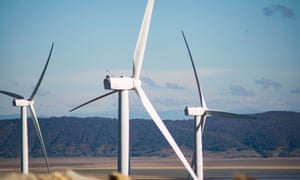Extract from The Guardian
The Clean Energy Finance Corporation has made a multi-million dollar loan for a new windfarm in Barnaby Joyce’s electorate.
It comes three months after Joyce slammed the South Australian government’s over-reliance on wind power, and linked SA’s damaging September blackout on the state’s lack of coal-fired baseload power.
The new Sapphire windfarm will become the largest in NSW, powering 110,000 average homes and abating 600,000 tonnes of carbon emissions a year, with 75 wind turbines.
The CEFC says its $120m loan will send an important signal to the industry that large-scale greenfield renewable energy assets can still get financing, despite the policy uncertainty emanating from Canberra.
“In order to achieve Australia’s renewable energy target, we need to see the accelerated development of many more large-scale renewable energy projects in the near term,” CEFC wind sector lead, Andrew Gardner, said.
Australia’s chief scientist, Dr Alan Kinkel, warned last week that investment in the electricity sector had stalled because of “policy instability and uncertainty”.
Over the weekend, the Australian Financial Review reported the pioneering Australian wave-power company Carnegie Wave Energy was planning to build its first commercial wave plant in Cornwall, England, because the climate policy chaos in Australia was too much.
Carnegie is a former recipient of a $20m loan from the CEFC in 2014. The loan was the CEFC’s first wave-energy investment.
The new Sapphire windfarm, worth $588m, will be located between Glen Innes and Inverell in the New England region of northern NSW, in Joyce’s electorate.
It will produce a daily maximum 270 megawatts of electricity, 100 megawatts of which have been contracted to the ACT government to help the government meet its 100% renewable energy target by 2020.
The windfarm developer is CWP Renewables, the same outfit behind the Boco Rock windfarm in southern NSW.
In September, on the morning after damaging storms caused South Australia’s statewide blackout, Barnaby Joyce, during three separate interviews, argued the state had become too reliant on renewable energy, wind in particular.
His comments were contradicted by the environment minister, Josh Frydenberg, who said repeatedly the blackout was caused by severe weather and was not linked to renewables.
The storm had torn more than 2o separate transmission towers from the ground.
In April, in the lead-up to the federal election campaign, Joyce had promoted a different windfarm in his electorate to send a pro-renewable message to voters to combat his political opponent, Tony Windsor.
He said his electorate would be home to the largest windfarm in NSW, helping to broaden the local economy as part of a strategic plan.
Besides the CEFC’s $120m direct loan, the balance of the windfarm’s $588m debt package has been provided through EKF, Denmark’s export credit agency, the Commonwealth Bank of Australia and Sumitomo Mitsui Banking Corporation.
ANZ Financial Advisory managed the debt raise and Norton Rose was the legal advisor to the project.
It comes three months after Joyce slammed the South Australian government’s over-reliance on wind power, and linked SA’s damaging September blackout on the state’s lack of coal-fired baseload power.
The new Sapphire windfarm will become the largest in NSW, powering 110,000 average homes and abating 600,000 tonnes of carbon emissions a year, with 75 wind turbines.
The CEFC says its $120m loan will send an important signal to the industry that large-scale greenfield renewable energy assets can still get financing, despite the policy uncertainty emanating from Canberra.
“In order to achieve Australia’s renewable energy target, we need to see the accelerated development of many more large-scale renewable energy projects in the near term,” CEFC wind sector lead, Andrew Gardner, said.
Australia’s chief scientist, Dr Alan Kinkel, warned last week that investment in the electricity sector had stalled because of “policy instability and uncertainty”.
Over the weekend, the Australian Financial Review reported the pioneering Australian wave-power company Carnegie Wave Energy was planning to build its first commercial wave plant in Cornwall, England, because the climate policy chaos in Australia was too much.
Carnegie is a former recipient of a $20m loan from the CEFC in 2014. The loan was the CEFC’s first wave-energy investment.
The new Sapphire windfarm, worth $588m, will be located between Glen Innes and Inverell in the New England region of northern NSW, in Joyce’s electorate.
It will produce a daily maximum 270 megawatts of electricity, 100 megawatts of which have been contracted to the ACT government to help the government meet its 100% renewable energy target by 2020.
The windfarm developer is CWP Renewables, the same outfit behind the Boco Rock windfarm in southern NSW.
In September, on the morning after damaging storms caused South Australia’s statewide blackout, Barnaby Joyce, during three separate interviews, argued the state had become too reliant on renewable energy, wind in particular.
His comments were contradicted by the environment minister, Josh Frydenberg, who said repeatedly the blackout was caused by severe weather and was not linked to renewables.
The storm had torn more than 2o separate transmission towers from the ground.
In April, in the lead-up to the federal election campaign, Joyce had promoted a different windfarm in his electorate to send a pro-renewable message to voters to combat his political opponent, Tony Windsor.
He said his electorate would be home to the largest windfarm in NSW, helping to broaden the local economy as part of a strategic plan.
Besides the CEFC’s $120m direct loan, the balance of the windfarm’s $588m debt package has been provided through EKF, Denmark’s export credit agency, the Commonwealth Bank of Australia and Sumitomo Mitsui Banking Corporation.
ANZ Financial Advisory managed the debt raise and Norton Rose was the legal advisor to the project.

No comments:
Post a Comment